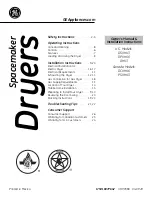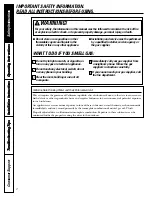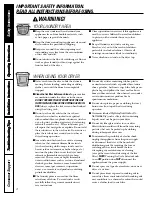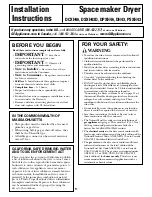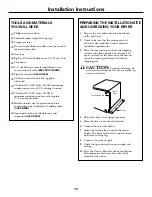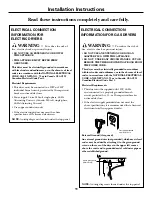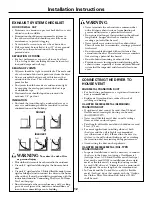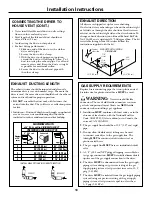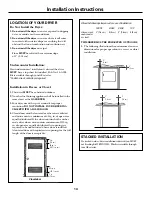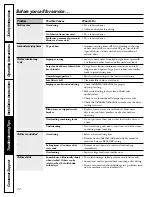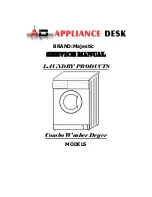
Installation Instructions
12
WARNING
• Never terminate the exhaust into a common duct
with a kitchen exhaust system. A combination of
grease and lint creates a potential fire hazard.
• Do not use duct longer that specified in the exhaust
length table. Longer ducts can accumulate lint,
creating a potential fire hazard.
• Never install a screen in or over the exhaust duct.
This will cause lint to accumulate, creating a potential
fire hazard.
• Do not assemble ductwork with any fasteners that
extend into the duct. These fasteners can accumulate
lint, creating a potential fire hazard.
• Do not obstruct incoming or exhausted air.
• Provide an access for inspection and cleaning of the
exhaust system, especially at turns and joints. Exhaust
system shall be inspected and cleaned at least once
a year.
EXHAUST SYSTEM CHECKLIST
HOOD OR WALL CAP
• Terminate in a manner to prevent back drafts or entry
of birds or other wildlife.
• Termination should present minimal resistance to
the exhaust airflow and should require little or no
maintenance to prevent clogging.
• Never install a screen in or over the exhaust duct.
• Wall caps must be installed at least 12
″
above ground
level or any other obstruction with the opening
pointed down.
SEPARATION OF TURNS
• For best performance, separate all turns by at least
4 ft. of straight duct, including distance between last
turn and dampened wall cap.
SEALING OF JOINTS
• All joints should be tight to avoid leaks. The male end
of each section of duct must point away from the dryer.
• Do not assemble the ductwork with fasteners that
extend into the duct. They will serve as a collection
point for lint.
• Duct joints should be made air- and moisture-tight
by wrapping the overlapped joints with duct tape
or aluminum tape.
• Horizontal runs should slope down towards the
outdoors 1/4
″
per foot.
INSULATION
• Ductwork that runs through an unheated area or is
near air conditioning should be insulated to reduce
condensation and lint buildup.
WARNING
To reduce the risk of fire
or personal injury:
• This clothes dryer must be exhausted to the outdoors.
• Use only 4" rigid metal ducting for the home exhaust
duct.
• Use only 4" rigid metal or UL-listed flexible metal (semi-
rigid or foil-type) duct to connect the dryer to the home
exhaust duct. It must be installed in accordance with the
instructions found in "Connecting The Dryer To House
Vent" on this page.
• Do not terminate exhaust in a chimney, a wall, a ceiling,
gas vent, crawl space, attic, under an enclosed floor, or
in any other concealed space of a building.
Correct
Incorrect
Do
Don’t
Don’t
Don’t
CONNECTING THE DRYER TO
HOUSE VENT
RIGID METAL TRANSITION DUCT
• For best drying performance, a rigid metal transition
duct is recommended.
• Rigid metal transition ducts reduce the risk of
crushing and kinking.
UL-LISTED FLEXIBLE METAL (SEMI-RIGID)
TRANSITION DUCT
• If rigid metal duct cannot be used, then UL-listed
flexible metal (semi-rigid) ducting can be used
(Kit WX08X10077).
• Never install flexible metal duct in walls, ceilings,
floors or other enclosed spaces.
• Total length of flexible metal duct should not exceed
8 feet (2.4 m).
• For many applications, installing elbows at both
the dryer and the wall is highly recommended
(see illustrations at left). Elbows allow the dryer to
sit close to the wall without kinking and/or crushing
the transition duct, maximizing drying performance.
• Avoid resting the duct on sharp objects.
UL-LISTED FLEXIBLE METAL (FOIL-TYPE)
TRANSITION DUCT
• In special installations, it may be necessary to connect
the dryer to the house vent using a flexible metal
(foil-type) duct. A UL-listed flexible metal (foil-type)
duct may be used ONLY in installations where rigid
metal or flexible metal (semi-rigid) ducting cannot
be used AND where a 4" diameter can be maintained
throughout the entire length of the transition duct.
• In Canada and the United States, only the flexible
metal (foil-type) ducts that comply with the “Outline
for Clothes Dryer Transition Duct Subject 2158A”
shall be used.

